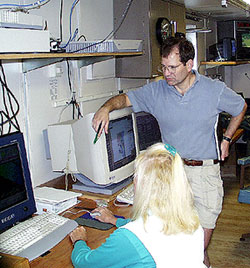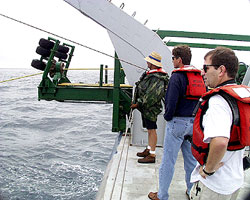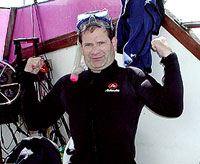Galápagos Islands
Expedition 5:
Aug 23-Sep 24, 2001
Mission & Objectives
Daily Updates
Mail Buoy
Scientists & Crew
Interviews
Hot Topics
Slideshows
Videos
Activities
Glossary
|
Interviews: Chief Scientist Mark Kurz
 Mark Kurz, after five years of planning, is finally getting the opportunity
to map and sample the submarine volcanoes of the Galápagos
in extraordinary detail. Here he is discussing the operation of the
multibeam sonar data with Uta Peckman. Mark Kurz, after five years of planning, is finally getting the opportunity
to map and sample the submarine volcanoes of the Galápagos
in extraordinary detail. Here he is discussing the operation of the
multibeam sonar data with Uta Peckman.
Mark Kurz’s advice to students looking to go on to graduate school sounds simple: “Do what you enjoy.” But in actuality, it’s a challenge. “To do a Ph.D., you have to be really interested in the research topic,” he says. “It's very difficult to find something that is really exciting to you; that you can find funding for and that really advances the science all at the same time.”
 |
 |
| Wearing work vests for safety, Mark, Chris Curl (center) and Gene Pillard oversee the deployment of the MR1 sonar fish. |
Mark looks at rocks and finds ancient secrets of the planet. But he didn’t know this was what he was going to do in 1976, when he graduated from the University of Wisconsin at Madison with a bachelor’s of science degree in chemistry.
A year after starting graduate school at the Woods Hole Oceanographic
Institution, where he began studying ocean chemistry, he jumped at
the chance to board the RV Knorr for an expedition to the
Galápagos Spreading Center. This was the trip that would revolutionize
oceanography with the discovery of hydrothermal vents. That cruise
inspired Mark to change his research focus. He began measuring noble
gases trapped in deep-sea volcanic rocks.
This is now his sixth trip to the Galápagos Islands. “Most of my work in the Galápagos has been above sea level,” he says. “The submarine parts are really unknown, which is why this cruise is so exciting to me.”
Mark grew up in Waukesha, Wisconsin, where his parents still live. “My mother is an artist and she loves rocks. I think I inherited my love of rocks from her.” Mark’s own family lives in Falmouth, Mass. He is usually out at sea or on other research expeditions once a year for a month. When he is at home he enjoys bike riding, swimming and occasionally jogging with his 13- and 16-year-old daughters, Olivia and Nellie. “My wife, Slim, has a beautiful garden in the back yard. She’s a landscaper and loves to be outside with her plants and flowers.”
 |
 |
| With hot tea to keep him going, Mark works late on his laptop in the Main Lab. |
Mark’s travels have taken him to Antarctica, the Amazon, Iceland, the south Atlantic, Samoa and Hawaii. In 1985, when he was studying Haleakala Volcano on Maui, Hawaii, he linked a strange phenomenon at the top of the volcano to bombardment of cosmic rays from space. Only on the Moon had scientists seen cosmic rays hit a rock’s surface and produce He3. This type of helium also gave geologists a new way of dating rocks on Earth’s surface. “That’s what I love about science, it can lead you in new directions and changes the way you think, opening up all sorts of new possibilities.”
He is especially enthusiastic about this trip because it will give him the opportunity to relate his previous work on dating the Galápagos volcanoes with the geochemistry of the submarine lava we hope to dredge up on this cruise. “This trip combines my two very different research interests: cosmogenic helium, which affects rocks on the surface, and the study of Earth’s deep interior through the geochemistry of submarine volcanoes.”
 |
 |
 |
Our 'super' Chief Scientist, Mark Kurz, as he gets ready to go snorkeling with sea lions. |
Our
current expedition will be the most comprehensive study of the western
side of the volcanoes, he says. “For me that’s extremely
exciting. That’s where all the action is -- on the leading edge
of the Galápagos hot spot.” |

 Mark Kurz, after five years of planning, is finally getting the opportunity
to map and sample the submarine volcanoes of the Galápagos
in extraordinary detail. Here he is discussing the operation of the
multibeam sonar data with Uta Peckman.
Mark Kurz, after five years of planning, is finally getting the opportunity
to map and sample the submarine volcanoes of the Galápagos
in extraordinary detail. Here he is discussing the operation of the
multibeam sonar data with Uta Peckman.

